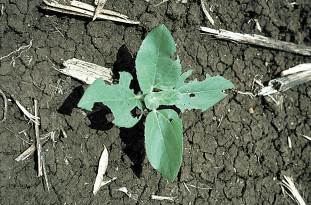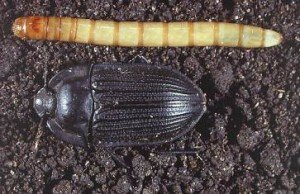Crops are most susceptible to pest damage at the seedling stage. Pests feeding on seedlings can reduce plant establishment, increase weed competition, delay flowering and lower yields. In some cases there may be a need for re-sowing.
Most of the establishment pests found in the northern region are soil-dwelling insects. Soil insects may be difficult to detect prior to sowing. The key principles that underpin management strategies for establishment pests include pest identification and monitoring. Knowledge of paddock histories also benefits decision making for establishment pests. This is especially the case for resident pests but more difficult for transient pests that are more mobile and move greater distances.
Farm management and different cultivation practices can influence the type and number of establishment pests. For example;
- Weedy fallows and volunteer crops encourage soil insect build-up
- Insect numbers decline during a clean long fallow due to lack of food
- High stubble levels on the soil surface can promote some soil insects due to a food source but this can also mean that pests continue feeding on the stubble instead of germinating crops.
- Crops after pasture can have high levels of scarab larvae
- Zero tillage encourages beneficial predatory insects and earthworms but also some establishment pests.
- Incorporating stubble promotes black field earwig populations.
- False wireworms are found under all intensities of cultivation but decline if stubble levels are very low
Soil insect control measures are normally applied prior to, or at, sowing. Since different insects require different control measures, the species of soil insects posing a threat to the crop must be identified before planting.
Monitor for soil insects
Soil sampling
This involves taking random spade samples across the field. Ensure spade samples are deep enough to take in the moist soil layer as many soil insects inhabit this interface between dry and moist soil. Hand-sort samples to determine the type and number of insects. Spade sampling can be done for all soil-dwelling pests however it is laborious, time consuming and difficult in wet soils.
Germinating seed baits
Seed baits can be used to monitor for the presence of wireworms, earwigs and wingless cockroaches.
- Soak insecticide-free crop seed in water for at least two hours (or overnight) to initiate germination. Use the type of seed to be sown e.g. if planting sorghum, use sorghum seed for the baits.
- Bury a dessert spoon full of the seed under 1 cm of soil at each corner of a 5×5 m square at five widely spaced sites per 100 ha.
- Place baits at the interface of the moist subsurface soil. In very dry soil, water the baits to ensure germination. The insects are attracted to the germinating seed, not the seed itself.
- Don’t forget to mark the position of the baits.
- Five days after placing the baits, dig up the germinating seed and count the insects.
Although monitoring for soil insects may seem time consuming, not knowing the potential risk may be more costly in the end if re-sowing is required.
Watch a ‘how to’ video on the preparation and use of germinating seed baits.
Managing soil insects
Cultural control
Crop residues and weedy fallows favour survival of soil insects.
Cultivation can reduce some soil dwelling insects by exposing them to adverse environmental conditions, thus preventing population increases.
Use higher seeding rates to compensate for seedling losses expected.
The use of press wheels at sowing increases compaction of soil around the seed to enhance germination and can also reduce movement of pests in the soil.
Chemical control
Insecticides may be applied to soil or seed at sowing. Seed treatments can protect the seed and seedling from low to moderate attack by insects during emergence and establishment. Seed treatments that contain imidacloprid, fipronil and thiamethxam provide some protection from various soil dwelling pests. Please note that cutworms are not controlled by seed applied chemistry.
The use of soil-incorporated insecticides can have a significant impact on other insects in the soil including beneficials. Grain baits containing insecticide applied at sowing offer good protection from black field earwigs and false wireworm adults.
If damage occurs after sowing, no treatment is available, other than re-sowing bare patches with an insecticide treatment. Sowing summer crops in fields with very high populations of soil insects should be avoided.
For more information about establishment pests and available thresholds visit: http://ipmguidelinesforgrains.com.au and ‘how to recognise and monitor soil insects’ on the DAFF website.



